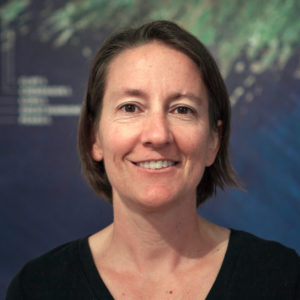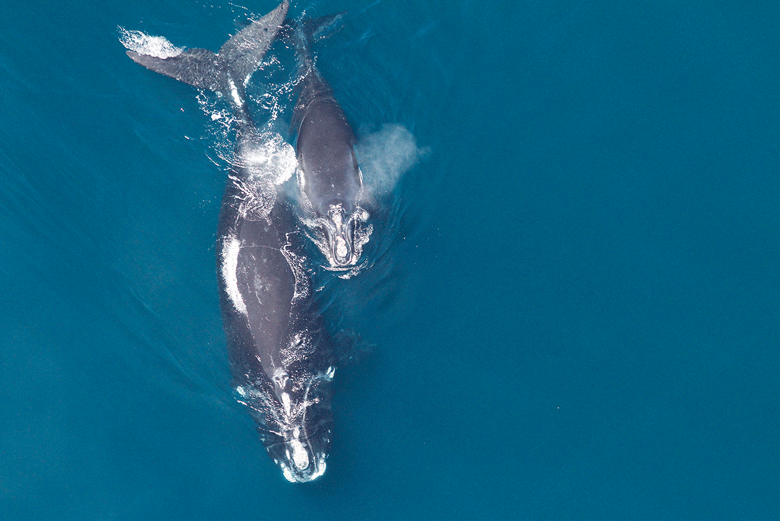You might think keeping track of a 100,000 pound animal would be easy. But when its home has no boundaries and its prey moves with changing ocean circulation within the vast Atlantic, it presents a challenge.
Then there’s the fact that there are only around 350 remaining and they aren’t yet able to be tagged for more than a couple weeks at a time. It’s more like trying to keep track of 350 needles in a haystack.
This is part of the problem in trying to prevent the extinction of the critically endangered North Atlantic right whale. If we don’t know where they are, it is difficult to implement rules to effectively protect them.
Right whales aren’t particularly loud, and we don’t have a good understanding of how often they are being vocal.
The ocean is a surprisingly busy place and the tradeoffs and disruptions to industry to protect whales are complex and inequitable. For example, we know that ship strikes are a major cause of mortality and serious injury for whales. Yet vessel slow zones in the Gulf of Maine are currently voluntary.
Without mandatory speed limits in areas where whales are and serious disincentives to break the rules, ship strikes will continue to kill whales. The key is knowing where the whales are, and when. Otherwise, we’ll have broad-brush rules put in place for “what if” scenarios that are unnecessary most of the time.
So what systems are in place for detecting whales? Dr. Anita Murray of the Cetacean Research Program at Maine Department of Marine Resources (DMR) is leading the passive acoustic monitoring of right whales.
“Historically, there hasn’t been the same level of monitoring for right whales in Maine waters as other areas, such as Cape Cod Bay,” she says, “therefore our understanding of where and when right whales occur off the coast of Maine is limited.”
Because right whales’ preferred food has shifted from traditional foraging grounds since 2010, they no longer tend to aggregate in the Gulf of Maine. Thus, visual sightings from aerial or boat surveys are less likely to find whales. Visual surveys require plane or boat time and operators and observers, and the whale must be at the surface to be seen.
Given the lower numbers of right whales off the coast of Maine, passive acoustic monitoring stations are more likely to pick up a whale than visual surveys. These stations can tell us when whales are present and vocalizing.
All right whales make a unique sound, called an upcall. Imagine a low pitched and rising “whooooop” sound. Right whales aren’t particularly loud, and we don’t have a good understanding of how often they are being vocal. Scientists estimate that a station can usually detect a vocalizing right whale up to six miles away without boat motors or other interfering noise.

Passive acoustic monitoring data is recorded on a memory card that needs to be retrieved every 4-5 months and run through an automated low frequency detection and classification system and then verified. The Gulf of Maine currently has nine stationary listening stations operated by DMR in collaboration with the University of Maine, and eight operated by the Northeast Fisheries Science Center in cooperation with DMR. The University of Maine and others also fly gliders equipped with acoustics to listen for whales on preprogrammed routes of interest.
DMR will be getting more funding for monitoring whales, so there’s an opportunity to be strategic with an expanded array. There also is a push to get more near real-time passive acoustics with satellite links. This could inform dynamic management in discrete areas of elevated risk, like shipping lanes or potentially small areas of the coast with higher densities of fishing gear.
There are a lot of unknowns about how whales use the Gulf of Maine, and these unknowns have serious implications for other ocean users.
“An ideal monitoring plan,” Murray says, “combines all available methods, particularly passive acoustic monitoring with visual surveys so you get presence data when whales are underwater and vocalizing, and when they are at the surface, giving us a more complete picture of when and where whales occur in Maine waters.”
With improved information about whale location, sensible regulations can be crafted to protect them while allowing for other ocean uses.
Susie Arnold is a senior ocean scientist with the Island Institute, publisher of The Working Waterfront. She may be reached at sarnold@islandinstitute.org.





